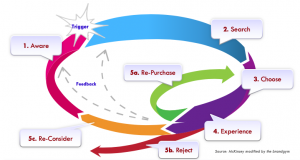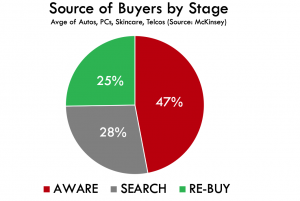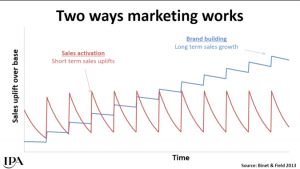Is mass marketing dead, in an age when you can micro-target sub-segments and personalise your message with online marketing? Or, is mass marketing to reach as many people as possible still the best way to build your brand and business, as Byron Sharp suggests?
Mark Ritson’s recent column (1) asked this question and we explore a possible answer below.
Micro-targeting: SEARCH stage
Micro-targeting focuses on the SEARCH stage of the customer decision journey (below), that we posted on here.
Hit the right people at the right time with the right message, when they’re actively searching for a product or service. If we’re selling puppy food, for example, let’s just target owners of puppies, and not waste money on non-dog owners.

Micro-targeting at the search stage is great. However, only c.28% of decisions are actually made at this stage, according to McKinsey research on several consumer categories (see below).
In fact, almost half of decisions are made at the AWARE stage. These people did search, but they already had an idea of what to buy based on longer-term awareness. A further 25% of people decided to re-buy the same brand, which is a reflection on how good their customer experience was.

Mass Marketing: AWARENESS stage
So building brand awareness is key. You need to make your brand ‘salient’, as Byron Sharp would say.
Back to the puppy food example, it makes sense to invest some money in building brand awareness amongst a broader group of people than just current puppy owners. That way, when people do get a puppy, they already have an idea in their head of our brand.
And this is where mass marketing comes in. Big, creative, impactful marketing campaigns using mass media such as TV, radio and outdoor and more likely to build top-of-mind awareness. Examples we’ve posted on include John Lewis, Guinness and Direct Line. Importantly, the fact that these campaigns are NOT personalised is part of what makes them special. They are shared experiences that people can talk about and discuss.
The Brexit example
An example of mass and micro marketing working in perfect harmony is, I’m sorry to say, the Brexit Leave campaign!
Millions of micro-targeted online ads appealed to peoples’ particular fears and prejudices with scary efficiency, such as the example below. A total of 1,433 different messages were used, according to one report (2). The campaign learnt which messages were most effective for each person, and served them more of these.
(The ‘weaponised ad campaign’ was so effective that the UK government’s data protection authority has called for an “ethical pause” in the use of personal information in political micro-targeting.) (3)

But on the other hand, the campaign also benefited from some highly impactful mass marketing. First, there was a unifying slogan which tapped into the desire of certain groups to “Take Back Control” of the UK. And then we had the ‘Boris Brexit Bus’, with the (dubiously accurate) message about funding the National Health Service (NHS), not the EU.

What split should I use?
So, having seen the role played by targeted, sales-driven marketing and mass marketing, how should you split your marketing investment. The most effective campaigns (in terms of share and profit growth) have a 60:40 split between brand building (more mass) and activation efforts (more targeted), according to IPA research was posted on here. This split delivers short term ‘blips’ in sales, but also enhances brand equity to deliver long term growth (see below).

In conclusion, mass targeting and micro targeting are a marketing marriage made in heaven!
Sources:
(1) https://www.marketingweek.com/2018/08/02/mark-ritson-targeting-mass-marketing/
(2) https://www.bbc.co.uk/news/uk-politics-44966969
(3) https://www.nytimes.com/2018/08/16/technology/facebook-microtargeting-advertising.html
Featured image: https://cmpfun.blogspot.com/2015/07/targeted-marketing-versus-mass-marketing.html